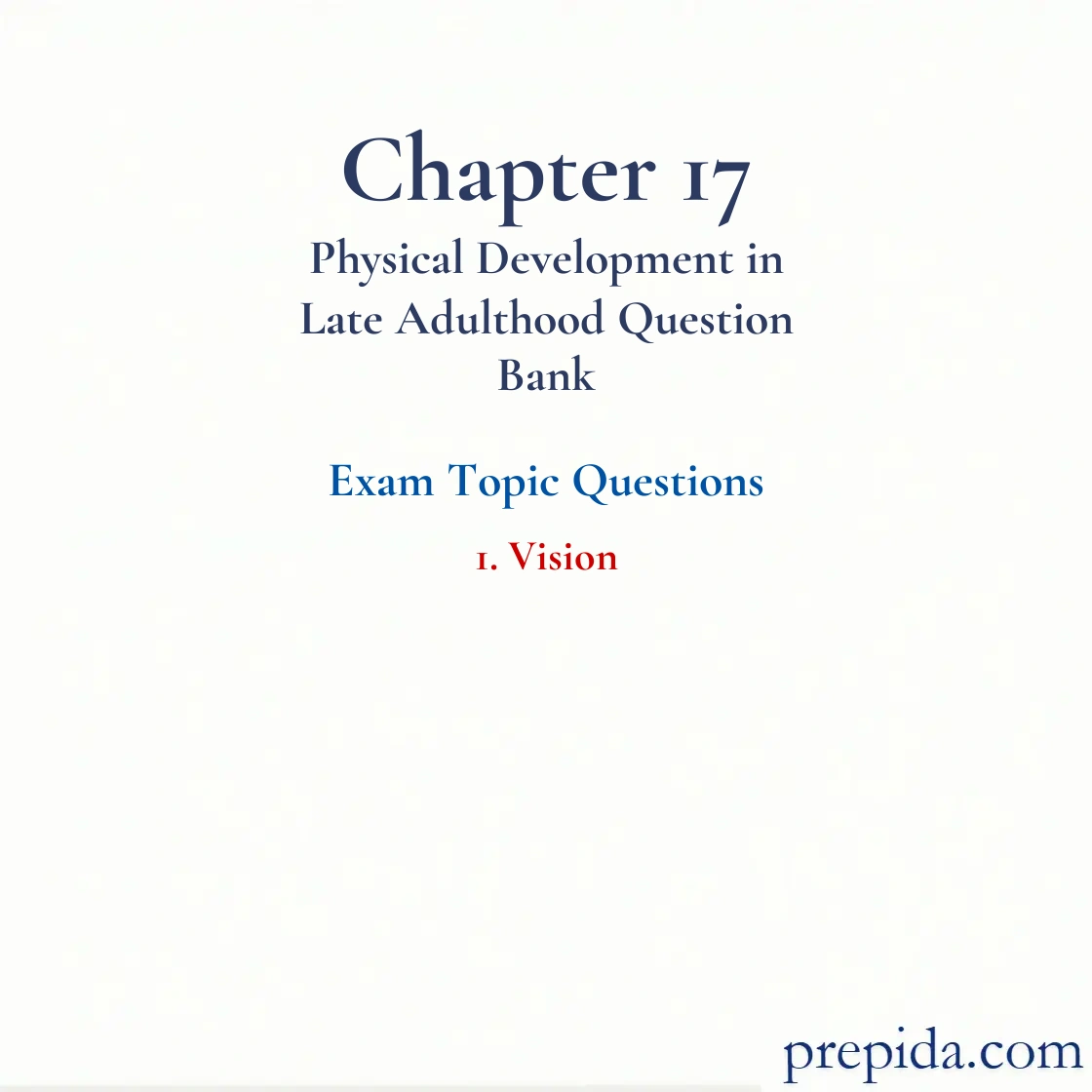
Which of the following is a risk factor in the development of cataracts?
- cardiovascular disease
- diabetes
- chronic obstructive pulmonary disease
- arthritis
Cataracts: A thickening of the lens of the eye that causes vision to become cloudy, opaque, and distorted.
Recently, researchers have found that visual decline in late adulthood is linked to
- cognitive decline.
- stroke.
- weakened diaphragm.
- increased touch sensitivity.
Cognitive Mechanics: The “hardware” of the mind, reflecting the neurophysiological architecture of the brain. Cognitive mechanics involve the speed and accuracy of the processes involving sensory input, visual and motor memory, discrimination, comparison, and categorization.
Why does night driving become especially difficult in late adulthood?
- because of diminishing sensitivity to contrasts and reduced tolerance for glare
- because of the decline in color vision
- because of increased tolerance for glare and increased sensitivity to contrasts
- because of the expanding area of the visual field
John is 70 years old. He has been a chain smoker throughout his adult years. Consequently, now he is unable to see clearly objects that are in close proximity even though he has a relatively normal peripheral vision. The disease that has marred John's vision is
- glaucoma.
- cataracts.
- macular degeneration.
- retinal hardening.
Macular Degeneration: A disease that involves deterioration of the macula of the retina, which corresponds to the focal center of the visual field.
What is a leading cause of blindness in older adults?
- presbyopia
- myopia
- macular degeneration
- retinal hardening
Macular Degeneration: A disease that involves deterioration of the macula of the retina, which corresponds to the focal center of the visual field.
Cynthia is 91 years old. Doctors have found that Cynthia's optic nerves have been damaged because of accumulation of fluid in the eye. Cynthia is worried that she will lose her vision, but the doctor has told her that her condition can be treated with eye drops. The disease that has marred Cynthia's vision is
- glaucoma.
- cataracts.
- retinopathy.
- macular degeneration.
Glaucoma: Damage to the optic nerve because of the pressure created by a buildup of fluid in the eye.
Lydia has been diagnosed with early macular degeneration. Which of the following treatments is her doctor most likely to recommend?
- eye drops
- removal of the lens of her eye
- prescription for glasses
- laser surgery
Macular Degeneration: A disease that involves deterioration of the macula of the retina, which corresponds to the focal center of the visual field.
Jake has been diagnosed with a condition characterized by damage to the optic nerve due to a buildup of fluid in the eye. Jake is suffering from
- glaucoma.
- cataracts.
- retinopathy.
- macular degeneration.
Glaucoma: Damage to the optic nerve because of the pressure created by a buildup of fluid in the eye.
Which of the following is a major disease that can impair the vision of older adults?
- myopia
- otosclerosis
- glaucoma
- tinnitus
Glaucoma: Damage to the optic nerve because of the pressure created by a buildup of fluid in the eye.
The vision of older adults can be affected by age-related changes. One of these changes, which can make steps or street curbs difficult to manage, is a decline in
- eye-hand coordination.
- depth perception.
- ocular elasticity.
- color vision.
Perception: The interpretation of what is sensed.
Which of the following is a result of declining color vision in the green-blue-violet part of the color spectrum?
- difficulty in accurately distinguishing between objects of closely related colors
- difficulty in accurately distinguishing between objects of contrasting colors
- difficulty in seeing colored objects that are at a distance
- difficulty in seeing objects that are very close
Perception: The interpretation of what is sensed.
In which part of the color spectrum is the loss of color vision most likely to occur?
- red-orange-yellow
- green-blue-violet
- yellow-violet-indigo
- green-yellow-orange
Perception: The interpretation of what is sensed.
Color vision declines with age because of
- the yellowing of the lens of the eye.
- a decline in the effectiveness of the cones to discriminate colors.
- cataracts preventing certain parts of the light spectrum from entering the lens of the eye.
- a reduction in the light entering the peripheral area of the visual field.
Cataracts: A thickening of the lens of the eye that causes vision to become cloudy, opaque, and distorted.
Gisela is suffering from a condition that involves thickening of the lenses of her eyes. This causes her vision to become cloudy or distorted. Identify the condition that Gisela is suffering from.
- glaucoma
- nearsightedness
- macular degeneration
- cataracts
Cataracts: A thickening of the lens of the eye that causes vision to become cloudy, opaque, and distorted.